Up to fifty percent of financial forensic services are performed in
divorces, or in family law business valuations. Providing the first
definitive publication on family law for accountants, this book
addresses topics unique to family law accounting, tax, valuation
and practice. The coverage begins with pre-engagement of the client
and proceeds through to trial and preparation and presentation.
Sample checklists, work papers, and trial exhibits are included.
CPAs and attorneys will benefit from this handbook's tips on
providing financial services in the family law arena.
Autorentext
Donald A. Glenn, CPA, CFE, ABV, CFF, CVA, is a nationally known lecturer to judges, attorneys, CPAs and other groups on Forensic Accounting and has authored hundreds of articles in the forensic area and on family law. He has over 30 years of experience in family law and is the co-author of the AICPA publication A CPA's Guide to Forensic Accounting for Divorce Engagements, 2005, and has authored several CPA courses covering family law and marital fraud. Glenn is a Partner with Glenn & Dawson LLP. He has served on the National Board of Directors of the Institute of Management Accountants (IMA) and has participated as faculty expert in the U. of California Hastings Law School trial advocacy program. He has served on numerous AICPA litigation and family law committees and is frequently appointed as Court's expert in family law matters.
Thomas Burrage, CPA, is Principal in Charge of Litigation and Valuation, Burrage & Johnson, CPAs, PLC. He performs expert witness in cases fraud malpractice, minority shareholder, economic damages and family law. He is co-author of Wiley's Divorce and Domestic Relations Litigation, and AICPA's CPA's Guide to Family Law Services, and a contributing editor to PPC divorce taxation publications.
Donald J. DeGrazia, CPA, ABV, is senior shareholder in the firm, Gold Meltzer Plasky & Wise, specializing in federal and state taxation, multi-state taxation, and matrimonial taxation. He is also Chairman of Integra International, Inc. He provides various court and arbitration testimony, including matrimonial expert witness.
William B. Stewart, CPA/ABV, CVA, CFE, is principal of William B. Stewart CPA firm, specializing in forensic accounting. His expertise includes business valuations, family law, mediation consulting, and business advisory services. He has been appointed by the courts as an auditor, expert and receiver in large commercial litigation, and family law cases. He is a frequent speaker to legal and accounting organizations.
Zusammenfassung
Up to fifty percent of financial forensic services are performed in divorces, or in family law business valuations. Providing the first definitive publication on family law for accountants, this book addresses topics unique to family law accounting, tax, valuation and practice. The coverage begins with pre-engagement of the client and proceeds through to trial and preparation and presentation. Sample checklists, work papers, and trial exhibits are included. CPAs and attorneys will benefit from this handbook's tips on providing financial services in the family law arena.
Inhalt
Preface xvii
Acknowledgments xix
Part One Family Law Litigation and Financial Experts 1
1 Introduction 3
1.1 Introduction 3
1.2 Development of Property Law 3
1.3 U.S. Property Systems 4
1.4 Role of Fault in Divorce 4
1.5 Support 4
1.6 Property Valuation 4
1.7 Property Division 4
1.8 Income Tax 5
1.9 Marital Fraud 5
1.10 Conclusion 5
2 Divorce Assignments and the Financial Expert 6
2.1 Initial Contact 6
2.2 Engagement Terms and Conditions 12
2.3 Case Management 14
2.4 List of Cases 18
2.5 Notes 21
3 Planning and Coordinating Discovery 22
3.1 Introduction 22
3.2 Forms of Discovery 24
3.3 Financial Experts 25
3.4 Expert Discovery 27
3.5 Evaluation of Adverse Expert 28
3.6 Conclusion 29
Part Two Child and Spousal Support 31
4 Child and Spousal Support 33
4.1 Introduction 33
4.2 Child Support Factors 34
4.3 Child Support Guidelines 35
4.4 College and Other Extraneous Expenses 36
4.5 Uniform Interstate Family Support Act 37
4.6 Full Faith and Credit for Child Support Orders Act 38
4.7 Introduction to Spousal Support (Alimony) 38
4.8 Spousal Support Factors 38
4.9 Types of Alimony 41
4.10 Income Available for Support 42
4.11 Imputation of Income: Ability to Earn 45
4.12 Imputation of Income: Assets 47
4.13 Double Dipping 47
4.14 Conclusion 48
4.15 Notes 49
Part Three Character of Property 51
5 Community Property or Equitable Distribution 53
5.1 Introduction 53
5.2 Definition of Property 54
5.3 Characterization of Property 55
5.4 Division of Community or Marital Property 57
5.5 Transmutation Agreements 58
5.6 Premarital Agreements 59
5.7 Tracing and Apportionment 61
5.8 Notes 62
6 Tracing Bank and Investment Accounts 64
6.1 Introduction: Circumstances and Objectives of Tracing 64
6.2 What Constitutes Separate Property and Community Property? 68
6.3 The Community Property Presumption and the Burden on Separate Property 69
6.4 Intent and Fiduciary Duty 70
6.5 Tracing Menu Choices in California 71
6.6 Putting on Tracing Evidence at Trial 75
7 Real Property 77
7.1 Real Property in Divorce 77
7.2 Personal Residence 78
7.3 Real Estate Investments 80
7.4 Apportionment of Separate Property Interests 82
7.5 Allocation of Income and Deductions during Pendente Lite Period 84
7.6 Notes 85
8 Retirement and Pension Plans in Divorce 86
8.1 Definitions 86
8.2 Defined Benefit Plans 88
8.3 Defined Contribution Plans 92
8.4 Hybrid Plans 96
8.5 Other Retirement Accounts: Individual Retirement Accounts 96
8.6 Annuities in Divorce 97
8.7 Keogh (or HR-10) Plans 103
9 QDROs 104
9.1 Retirement Plan Basics 104
9.2 Common QDRO Issues and Problems 108
9.3 Conclusion 112
9.4 Notes 112
10 Equity-Based Compensation: Stock Options 113
10.1 Introduction 113
10.2 Fundamental Issues that Need to Be Addressed 114
10.3 What Are Stock Options? 114
10.4 Option Valuation Overview 115
10.5 A Black-Scholes Valuation Exercise 116
10.6 Options as Marital Property 118
10.7 Taxation of Options 120
10.8 Distribution of Options 121
10.9 Conclusion 122
10.10 Resources 123
10.11 Notes 123
